
Set amidst the gently rolling landscape of Mid-Missouri, the farming community of Clark would normally pass completely unnoticed. When outsiders do visit this region, it’s most likely that they’re drawn to Columbia, a lively town some twenty miles to the south. Despite the proximity, Clark and Columbia could hardly be more different. Whereas Columbia, as the location of the main campus of the University of Missouri, is a progressive college town, the countryside around Clark is a home to the Amish, a German-speaking, Anabaptist Protestant sect that has barely reconciled to social and technological changes of the 19th century, let alone to 20th and 21st century developments.
* * *
If Americans think of the Amish, it’s usually Pennsylvania that springs to mind, though in fact more Amish live in neighbouring Ohio. The 70,000 or so Pennsylvania Amish are concentrated in the southeast corner of the state, especially in Lancaster County, where these so-called “plain people” constitute a particularly highly visible presence. Over recent decades, the Amish population has doubled in the United States, spreading out from their traditional Pennsylvania and Ohio heartlands due to high birth rates (families have an average of six or seven children) and a high proportion of young Amish who choose to commit to their church and traditional way of life. Today, there are said to be more than 300,000 Amish, spread across twenty states.
These recently established Amish settlements have resulted from migration, mainly westwards. New communities form for a number of reasons: moving to where farmland is more reasonably priced; to avoid government regulations which conflict with their religious beliefs; or as a consequence of internal disagreements concerning the Ordnung, the unwritten set of rules governing each community. Schisms have theological roots that are based on the Amish’s literal interpretation of the Bible, but disagreements can appear (at least to outsiders) to have petty causes, often over what forms of technology members are permitted to use.
Adhering to the most traditional rules are the so-called “Old Order” Amish. Most continue to use a Low German dialect that has long since died out in Europe. All maintain a way of life that echoes that of their ancestors who first arrived in America in the early 18th century, escaping wars and religious persecution in either the Palatanite region of what is now Germany, from neighbouring Alsace or from Switzerland, the 16th-century birthplace of Anabaptism.
For these Old Order Amish, anything that remotely resembles modern technology is resisted – most noticeably electricity, plumbing or motorised vehicles. A study by Eric Brende formulated two basic rules for the acceptance of technology by traditional Amish: it should be understood by all members of the community and it must be tested against the community’s core values and beliefs. The underlying premises are that social stability is maintained by agreeing on technological change, that technology should not require specialist workers and the technology that is used should be integrated into all aspects of personal life.
Amish groups do in reality accept some technological innovations, but to outsiders their rules can seem bewildering. For example, some groups allow zips (not just buttons and hooks) to be used in their clothing – and while all Amish agree to dress “modestly”, they often disagree as to what this actually means. Some Amish groups only permit the use of push-scooters, some allow bicycles, while others permit neither. Some Amish groups insist that only horse-drawn buggies and ploughs be used, while others allow land to be worked using motorised tractors and even drive trucks and cars. Some groups allow personal phones, some only use a shared phone booth, while others don’t allow phones at all, the restrictions being based on the view that phones interfere with the separation from the wider world and facilitate external contacts from developing. Although outsiders often have a nostalgic view of the Amish’s simple life, romanticising the low-technology and agrarian way of life, internal disputes can be fierce, not infrequently leading to the shunning of individuals and families and the forming of breakaway groups, often involving establishing new communities.
* * *
The Amish first settled in Missouri in the mid-1950s, attracted by the availability of cheap land. Large holdings could be purchased directly abutting others, with Old Order communities able to remain at a safe distance from outside influences and distractions. Over the past few decades, Missouri’s Amish population has been among the fastest growing in the country, today numbering more than 11,000 people.
Around 1,000 live on farms in the area between Clark and Sturgeon, north of Route 22, around Route Y, making it one of the largest Old Order Amish populations west of the Mississippi. They live discretely, working their farms and making a point of neither competing with businesses in town nor taking on regular paid employment as, say, carpenters. Although the area offers none of the commercialism of the Amish in Jamesport (Northwest Missouri) or the long-established Pennsylvania and Ohio communities, visitors to Clark do contribute to the local economy. The Amish here have created a successful produce auction, there’s a bakery selling freshly baked bread and pies and many of the local farms sell fruit and vegetables, homemade jams and preserves, as well as patchwork quilts and rugs.
You can certainly get some sense of Amish life while casually driving through the area’s backroads – stopping at farmhouses displaying notices of produce for sale or pausing by a fence to watch from a distance people working their land. Sellers are courteous, and people passing by in their buggies generally raise their hands to signal a greeting. Still, as interesting as my brief visit was, I cannot remember feeling, anywhere else in the world, quite such an interloper. This is hardly surprising. By limiting unnecessary contacts with outsiders, Amish have survived in America as a distinct people for almost three centuries. It’s now a safe bet that Amish life in Missouri will continue much as it does now for quite a while longer.
Check out this blog post on a winter visit to Missouri’s Amish country.



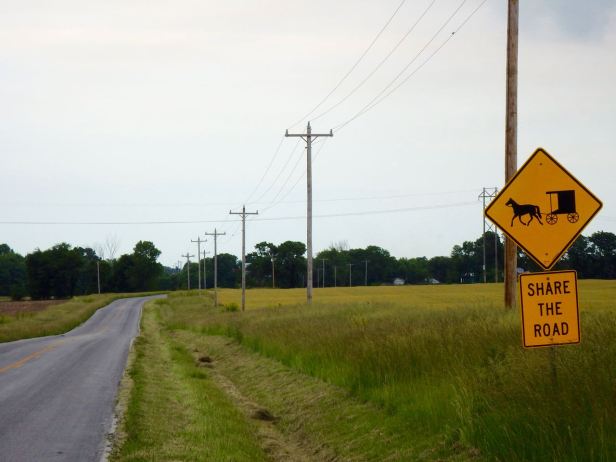
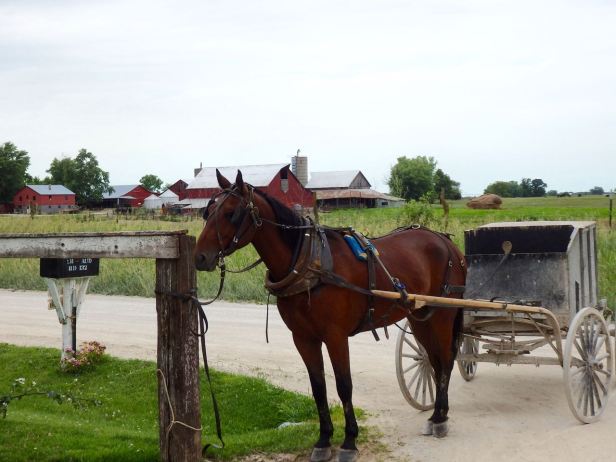







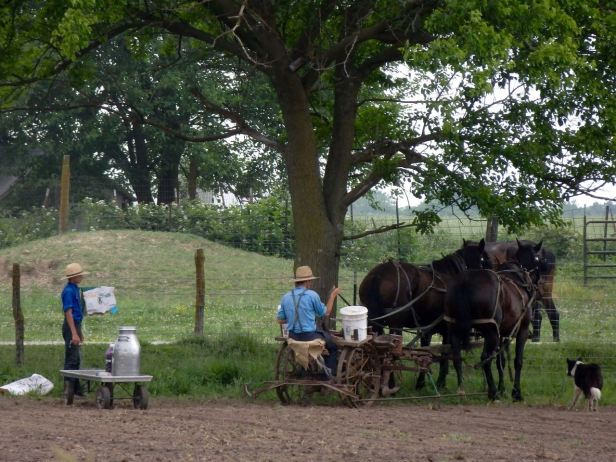
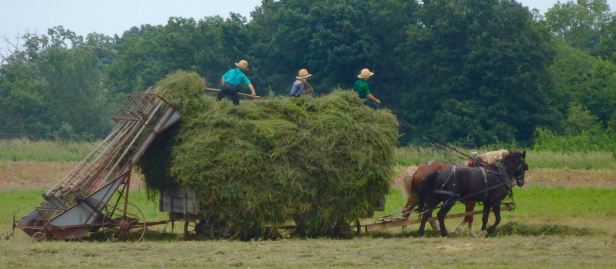
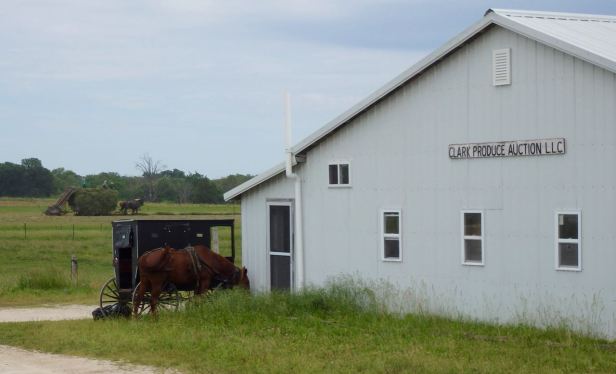



Terrific article! I hadn’t known there were Amish enclaves in Missouri. And excellent photos.
I grew up in the Finger Lakes region of NY, with Amish & Mennonite communities around us – -as you pointed out, the demand for farmland has them spreading far from Lancaster. This part of Upstate, and the Mohawk Valley, have many old farmhouses and road names from colonial and 19th c. German immigrants –Lutheran and Reformed (now often Methodist/Presbyterian) so the setting probably felt pretty comfortable to them. (My father’s family was originally from the Palatinate, and our name was Diehl, Anglicized to Teel just after the Revolution).
Farther north, near Ogdensburg/Heuvelton (St.Lawrence region) there are Schwenkfelders, spillover from Ohio.
You mentioned the hooks, snaps, etc.on clothing – – an aversion to buttons as they were often associated with uniforms, or a means for ostentatious display — some of the Old Order, won’t even use concealed hooks, and use straight pins, so even if you establish a friendly relationship, be careful if when you give someone a hug!
LikeLiked by 1 person
These pictures are absolutely gorgeous! Even though I live in Missouri, I’ve never visited the Amish communities. Thanks for writing this and, especially, for the photos.
LikeLiked by 1 person
Great article, lovely pictures. Thanks for sharing this.
LikeLiked by 1 person
We travelled through a tiny bit of Missouri and passed an Amish group on one of the back roads one day. It was a lovely but surreal moment on a long journey that day, they gave us lovely smiles and waved as we passed and we didn’t want to spoil the moment by stopping to take photos.
However, always wished we had taken more time to meet some Amish people as part of our road trip, especially as I suspect some of the similarities we would recognise coming from another isolated community (St Helena), albeit one that embraces technology.
Really enjoyed your article. I had always assumed the Amish population was declining but to learn they have in fact doubled recently is amazing. Great photos. The properties are also bigger than I had expected. Makes me think a lot of the farms we drove past now were probably Amish. Thanks so much. Cheers, Darrin.
LikeLiked by 1 person
How have I not replied to your comment until now? Thanks Darrin – I especially appreciate your nice words about my photos, as you’re a real photographer, whereas I just aim my lens and hope for the best! 🙂
LikeLike